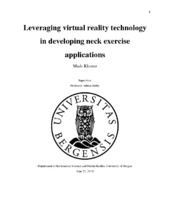| dc.description.abstract | The incorporation of Virtual Reality (VR) technology in developing application for purposes such as improving healthcare is prevalent in this era. In this thesis, we present two applications: VRFysio and NeckVR, which leverage VR technology in rehabilitation and neck exercises by using mobile-VR. Using design science in an iterative Spiral-model, the development of the applications was divided into four iterations. The first iteration was used to develop the VRFysio application. The VRFysio application focuses on mimicking neck-stretching. When evaluating the VRFysio application, the main questions to be answered were whether VR could contribute to treating neck problems, and what issues can be solved using the VRFysio application. The results revealed that motivation and working through the pain of exercising played a key role when using VRFysio application. The usability of the application was rated as satisfactory based on the usability tests conducted. The results from the evaluation of the VRFysio application enabled the development of the NeckVR application. This application consists of a VR-game whereby the player observes a black disk (the background), and boxes coming towards the disk. The goal is to move the reticle pointer over the boxes in order to destroy them before they hit the black disk. The application was tested by conducting evaluations, and open-ended interviews with Physiotherapists from the West Norwegian college. The feedback received from this evaluation was used in the third iteration. Additional features such as a timer, and a menu where the player can customize different parameters that will affect the game, such as speed and frequency, were included in the application in the third iteration. Usability evaluations and semi-structured interviews were also conducted in this iteration with physiotherapists from West Norwegian College to test the VR-game in the NeckVR application. The results revealed that the best use of the application was for getting patients to move an injured neck and especially for those who were suffering from fear of moving their neck due to severe pain or dizziness Both applications seemed to have potential, but in the current state could not be used freely as a part of any treatment. The physiotherapists are also required to guide the users through the first time of using the applications. The usability testing showed that NeckVR were easy to use. The overall indication is that VR was easy to use and that the participants testing the application seemed to enjoy using VR. The next logical step is to conduct clinical trials and test the application on the user group. Another inclusion for future work is, developing ways in which dates can be collected from the sensors in the smartphones and displayed to the users or those prescribing the treatment. | en_US |
